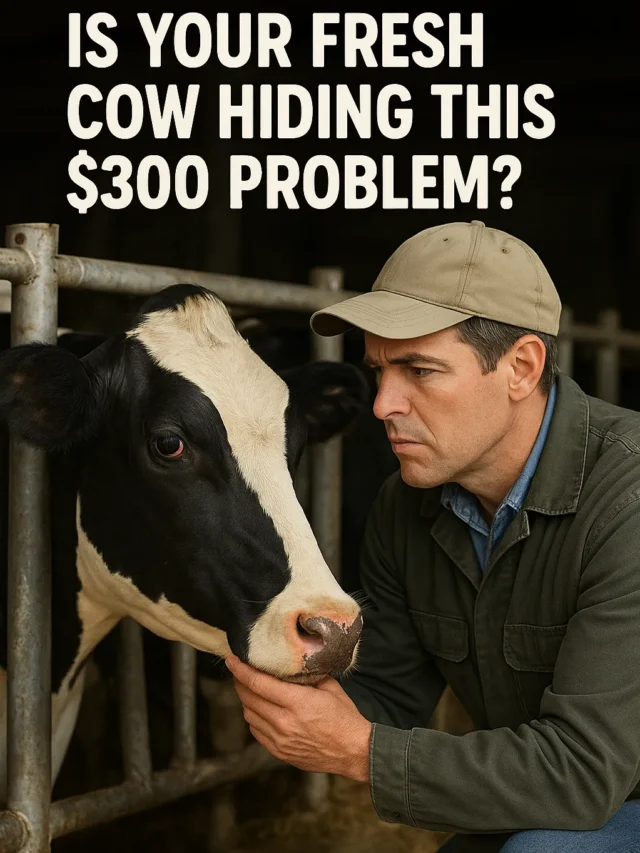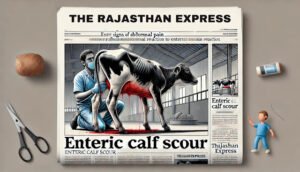Understanding Calf Scour (White Scour): Causes, Symptoms, and Treatment
White Scour, also known as Colibacillosis, is a prominent disease in newborn calves, particularly affecting those aged 1 to 3 days. It is caused by the bacterium Escherichia coli (E. coli). Calves suffering from this disease exhibit symptoms like severe watery diarrhea (white or yellow in color) and septicemia. Without timely treatment, the condition can lead to fatal outcomes. White scour is commonly observed in the offspring of cows, buffaloes, mares, and pigs.
Calf Scour (White Scour)
| Alternate Names |
|
|---|---|
| Causing Agent | Escherichia coli (E. coli) |
| Commonly Affected |
|
| Types |
|
| Main Symptoms |
|
| Transmission | Ingestion of food or water contaminated with infected feces |
| Pathogenic Strains |
|
| Diagnosis Methods |
|
| Treatment |
|
| Prevention |
|
| Key Peculiarity | Immediate colostrum feeding boosts immunity and ensures meconium passage |
| Learn more about Calf Scour: The Rajasthan Express | |
Causes of Calf Scour
The primary cause of white scour is the bacterium Escherichia coli, a Gram-negative bacterium responsible for septicemia and diarrhea. Key contributing factors include:
- Lack of Colostrum: Failure to provide colostrum within 24 hours of birth.
- Vitamin A Deficiency: A lack of sufficient vitamin A.
- Cold Stress or Weakness: Exposure to extreme cold or physical frailty.
When calves are not fed colostrum on time, their immune systems weaken, making them more susceptible to E. coli infections.
Strains of E. coli Bacteria
- In Calves: The pathogenic strain K99+ is commonly found.
- In Piglets: Pathogenic strains K99+ and K+ are observed.
Synonyms of Calf Scour
- White Scour, White Diarrhea, Colibacillosis.
Pathogenesis of Calf Scour
Healthy animals can contract the infection by consuming food or water contaminated with feces from infected animals. Once inside the gastrointestinal tract, E. coli produces three types of toxins:
- First Toxin: Causes hypotension and enteric calf scour.
- Second Toxin: Damages muscle endothelium, leading to septicemic calf scour.
- Third Toxin: Affects the gastrointestinal tract, resulting in enteric calf scour.
Symptoms of Calf Scour
The symptoms vary based on the type of colibacillosis:
1. Enteric Toxaemic Calf Scour
- Calf falls into a coma and its body becomes cold.
- Mucous membranes turn pale yellow.
- Severe diarrhea followed by death within 2-6 hours.
2. Septicaemic Calf Scour
- Symptoms appear typically 4 days after birth.
- Calf stops feeding and heart rate decreases.
- Swollen, painful joints causing lameness.
- Shivering and abnormal eye movement (nystagmus).
3. Enteric Calf Scour
- Most common in calves during the first three weeks after birth.
- Persistent watery diarrhea (white-yellow in color).
- High fever (105-106°F) and rapid pulse.
- Dehydration and refusal to feed.
- Abdominal pain causing the calf’s back to arch.
Diagnosis of Calf Scour
The disease can be diagnosed by:
- Examining fecal samples of affected calves.
- Observing clinical symptoms.
Differential Diagnosis:
- Coccidiosis: Usually affects calves aged 4 months to 2 years.
Treatment of Calf Scour
As E. coli is a Gram-negative bacterium, antibiotics like streptomycin are effective.
Prescription (Rx):
- Streptomycin Injection: 10 mg/kg of body weight, administered intramuscularly.
- Alternatively:
- Chloramphenicol/Tetracycline Injection: 5-10 mg/kg of body weight, administered intramuscularly.
Prevention of Calf Scour
Colostrum Feeding:
- Feed colostrum equivalent to 10% of the calf’s body weight.
- Alternatively, administer 100 ml/kg of colostrum based on body weight.
Immunity and Meconium Passage:
- Colostrum provides immediate immunity, enabling calves to resist infections.
- It also promotes the timely passage of meconium, which is vital for newborn health.
Discover how to prevent and treat calf scour (white scour) caused by E. coli. Learn about the symptoms, causes, and the importance of colostrum in calf health.
What is the cause of Colibacillosis?
What is Colibacillosis in pigs?
What is another name for Colibacillosis?
How can Colibacillosis be controlled?
- Ensure newborn calves receive colostrum immediately after birth.
- Provide clean and safe food and water.
- Address vitamin A deficiency.
- Protect calves from the cold with proper care.
What is the agent of Colibacillosis?
Which antibiotics are used to treat Colibacillosis?
- Streptomycin: 10 mg/kg of body weight.
- Chloramphenicol or Tetracycline: 5-10 mg/kg of body weight.
What is the differential diagnosis for Colibacillosis?
What are the symptoms of Colibacillosis in calves?
- Severe watery diarrhea (white or yellow in color).
- Dehydration and abdominal pain.
- Fever (105-106°F) and rapid pulse rate.
- Loss of appetite and refusal to drink milk.
- In severe cases, the calf may appear arched in the body.










